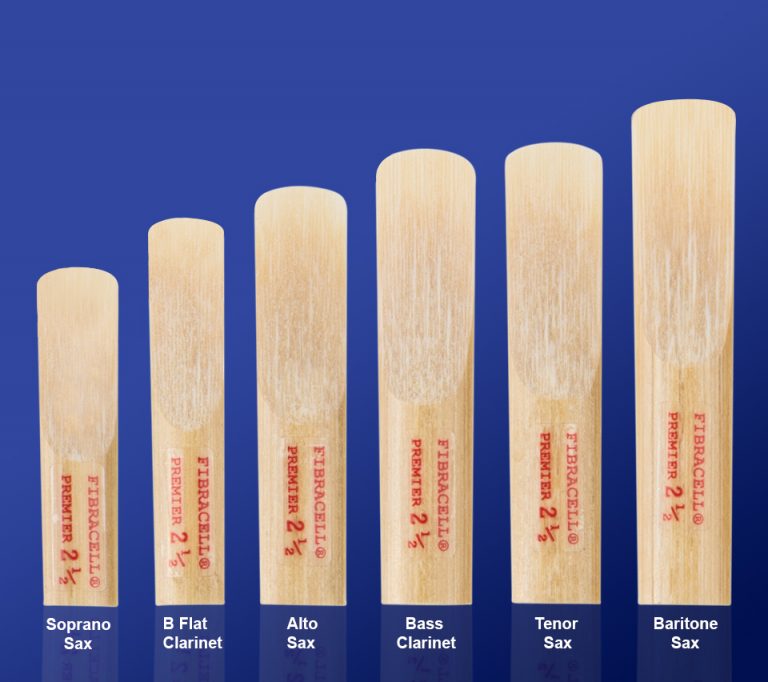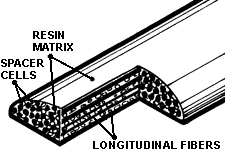GRADING CHART – CHOOSING THE CORRECT FIBRACELL REED.
THE FIBRACELL GRADING CHART ABOVE IS ONLY A SUGGESTED STARTING POINT FOR CHOOSING THE BEST FIBRACELL REED TO MATCH ONE’S PLAYING ABILITY AND INSTRUMENT AND MOUTHPIECE COMBINATION.
IT IS STRONGLY SUGGESTED THAT IN A PLAYERS FIRST ATTEMPT AT TRYING OUT THE FIBRACELL REED THAT THEY TRY 4 TO 6 FIBRACELL REEDS SO THEY CAN FIND THE BEST FIBRACELL GRADE CHOICE FOR THEIR INSTRUMENT.
IF A PLAYER HAS PLAYED THE FIBRACELL REED IN THE PAST BUT HAS NOT BEEN PLAYING THE FIBRACELL REED FOR SOME TIME AND THEY WANT TO TRY THEM AGAIN IT IS STRONGLY SUGGEST THAT THEY USE THE SAME METHOD AS IF THEY WERE FOR CHOOSING THE CORRECT GRADE OF FIBRACELL REED FOR THE FIRST TIME AS STATED ABOVE.
THE BIGGEST PROBLEM FOR LOTS OF PLAYERS WHEN FIRST TRYING TO FIND THE RIGHT FIBRACELL REED GRADE IS THAT THEY SIMPLY TAKE A BEST GUESS BASED ON THEIR CURRENT BRAND OR GRADE OF CANE REED, OR THEY JUST TAKE A QUICK LOOK AT THE FIBRACELL REED GRADING CHART AND CHOOSE ONE OR TWO FIBRACELL REEDS BASED ON THAT. THEN WHEN THEY GO OUT AND PURCHASE THOSE COUPLE OF REEDS AT THE STORE OR ONLINE AND THEY DON’T WORK PERFECTLY THEY JUST GIVE UP ON THE FIBRACELL REEDS ALTOGETHER.
IT MAY TAKE SEVERAL FIBRACELL REED GRADE CATEGORIES TO FIND THE PERFECT FIBRACELL GRADE.
FIBRACELLl Saxophone Clarinet Synthetic Composite Reeds
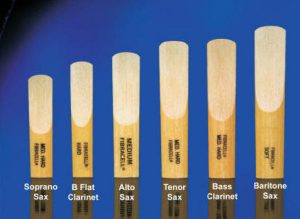
THE MOST EFFECTIVE APPROACH WHEN TRYING TO FIND THE BEST FIBRACELL REED IS TO USE THE GRADING CHART ABOVE ONLY AS A STARTING GUIDE AND A REFERENCE AND THEN CHOOSE THE MOST LIKELY FIBRACELL REED GRADE BASED ON THAT ASSESSMENT AND THEN ALSO PURCHASE ONE FIBRACELL REED FOR EACH OF AT LEAST TWO HALF GRADES ABOVE AND FOR TWO HALF GRADES BELOW THAT. USING THIS APPROACH WILL MOST CERTAINLY GIVE A PLAYER THE BEST CHANCE OF FINDING THAT PERFECT FIBRACELL REED GRADE!
REMEMBER ANY OF THE FIBRACELL REEDS THAT ARE PURCHASED THAT SEEM TO BE PLAYING A BIT HARDER OR A BIT SOFTER ARE GOING TO BE GREAT ON OTHER MOUTHPIECE OR JUST THE RIGHT FIT WHEN PLAYING DIFFERENT STYLES OF MUSIC OR IN DIFFERENT PLAYING SETTINGS.
- NEW REED CARE CONCERN -
Try NOT to TWIST your mouthpiece on or off of
your instrument with your FIBRACELL Reed on the
mouthpiece. Please remove the FIBRACELL reed
from your mouthpiece before TWISTING It.
Leaving the FIBRACELL Reed on your mouthpiece
while trying to TWIST it on or off can irreparably
damage the bottom of your FIBRACELL reed.
A very gentle adjustment of your mouthpiece to
position it, should NOT be a problem for your reed,
however, constant and consistent twisting of your
mouthpiece with your FIBRACELL reed underneath
a tight ligature can DAMAGE your FIBRACELL reed
beyond repair.
- FOR SUPPORT INQUIRIES PLEASE USE CONTACT FORM BELOW -
Here are some of our most frequently asked questions
FAQ

Features of Fibracell Reeds: Why does Fibracell sound so good? Because it’s not plastic and it’s not cane. It’s the most highly developed composite structure ever engineered for woodwinds! What Is A FIBRACELL Reed?
What You Don’t Get Is: cane’s inconsistent quality and short life.
Fibracell studied natural cane reed material under a microscope and used the most advanced fibers and composites from the aerospace industry to exactly duplicate the properties of natural cane reed material. Very stiff but sound absorbing Kevlar fibers are suspended in a lightweight resin formulation. It took the inventor, David W. Shaffer, over a decade of research to get the numbers of fibers, spacing, density of matrix, position of voids and other variables just right, but it was worth it. Fibracell is manufactured to exacting production standards and is precisely machined and trimmed for a consistently perfect shape. Experts in the fields of both music and manufacturing Fibracell have spent many years perfecting the formulas and processes used to make Fibracell reed material and to shape it into reeds that play the way musicians have always wanted but only rarely found in natural cane. In short, Fibracell is the epitome of consistency and quality. To the musician, that means a reed that won’t let you down. | ||||
| ||||
| ||||
| ||||
| ||||
GRADING CHART & CHOOSING FIBRACELL

Cleaning a FIBRACELL reed –
FIBRACELL reeds are a closed cell material and can best be cleaned and disinfected with warm water and a very mild soap or detergent. DO NOT use any kind of alcohol such as a rubbing alcohol or any other type of cleaning solvents to clean the FIBRACELL reed.
The cleaning product that is commonly found in music stores for testing mouthpieces called “Sterisol Germicide” is fine but apply it very lightly and then wash off with warm water and lightly dry the FIBRACELL reed before you attempt to play it or before placing it back in it’s case for storing.
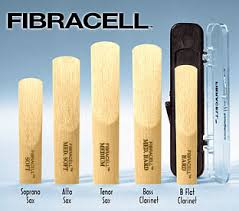
- CLIPPING THE TIP
WE RECOMMEND THAT YOU DO NOT TRY TO CLIP THE FIBRACELL REED TIP.
THE MANUFACTURING PROCESS REQUIRES A SPECIFICALLY DESIGNED INDUSTRIAL GRADE TIP CUTTER FOR THIS AND THERE IS NO TIP CUTTER AVAILABLE OUT IN THE MARKETPLACE THAT CAN BE PURCHASED TO ACCOMPLISH THIS TIP CUTTING PROCESS. ATTEMPTING TO CLIP THE TIP OF A FIBRACELL REED WITH A NORMAL REED TIP CUTTER WILL MOST CERTAINLY DESTROY THE REED.

YOUR FIBRACELL REED IS PLAYING TOO HARD –
IT IS OK TO USE A LIGHT GRADE SAND PAPER TO SAND THE TOP (AND ONLY ON THE TOP) OF THE FIBRACELL REED. PLEASE MAKE SURE TO CLEAN ANY SANDED MATERIAL OFF THE REED BEFORE PLAYING THE READ. SEE THE TAB FOR INSTRUCTIONS ON CLEANING A FIBRACELL REED LISTED BELOW THE SUPPORT SECTION IN THE TOOL BAR.
ALSO WHEN A FIBRACELL REED PLAYS A LITTLE HARDER OR SOFTER THAN IS DESIRED THE BEST FIRST STEP TO CORRECT THIS IS SIMPLY TO ADJUST THE FIBRACELL REED TIP SLIGHTLY UP OR DOWN OR RATHER CLOSER OR FARTHER FROM THE TIP OF THE MOUTHPIECE. THIS ONE SIMPLE STEP CAN HAVE A HUGE EFFECT ON THE PERFORMANCE AND SOUND OF THE FIBRACELL REED BUT IS OFTEN OVER LOOKED.
YOUR FIBRACELL REED IS PLAYING TOO SOFT
IF A NEW OR PREVIOUSLY USED FIBRACELL REED PLAYS SOFTER THAN IS DESIRED OTHER THAN THE ADJUSTMENTS THAT WERE SUGGESTED ABOVE THERE REALLY ISN’T ANY OTHER ADJUSTMENT SOLUTION AVAILABLE.
WITH A NORMAL CANE REED YOU MIGHT TRY TO CLIP THE TIP BUT DO NOT TRY TO CLIP THE TIP ON A FIBRACELL REED AS THIS WILL CERTAINLY DESTROY THE FIBRACELL REED ALTOGETHER. IN THIS SITUATION IT’S BEST TO HAVE A FEW OTHER FIBRACELL REEDS OF STRONGER GRADES ON HAND TO USE THAT MIGHT WORK BETTER.
SEE: CLIPPING THE TIP ON A FIBRACELL REED IN THE SUPPORT SECTION
Choosing Your FIBRACELL Reed
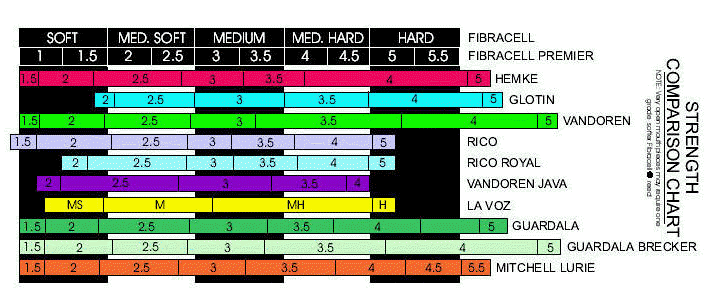
This Strength Comparison Chart Is ONLY A Place To Start In Narrowing Down Your Search For The Best FIBRACELL Reed For Your Particular Instrument Set Up.
For some, in the beginning, it can be a real challenge to find the right FIBRACELL reed that will work for them. This, however, can easily be the case for finding or changing to any other woodwind reed.
It’s also never easy to switch or add any other additional tools for your musical instrument(s) that you can depend on. Especially if what you’ve been using has worked well for you up until the time you decide you need to make a change. Whether it’s your reeds your mouthpieces or even your horns, when you go to practice, rehearse or especially when you’re standing in front of an audience you NEED everything to perform beautifully….so you can.
If you are looking for a synthetic composite reed that will give you the same feel, sound and the performance of the very best cane reed that you’ve ever been able to find and play…then you’ve found it in FIBRACELL.
FIBRACELL is without question the most cane like look, feel and sound of any synthetic composite woodwind reed on the market today! Read More...

